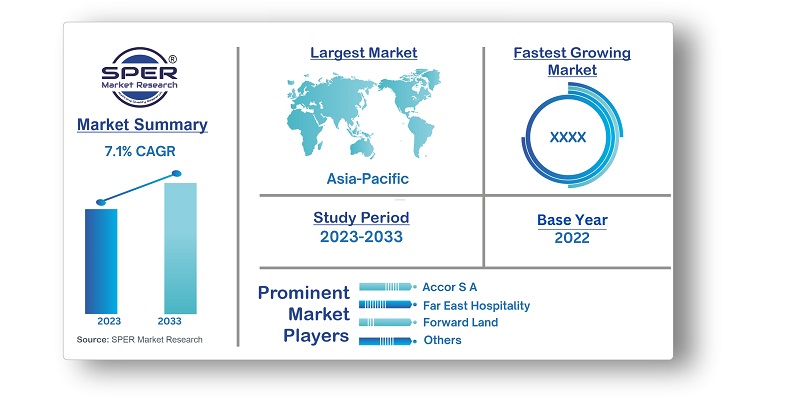
Singapore Hospitality Market Growth, Trends, Demand, Size, Revenue, Share and Future Outlook
Singapore Hospitality Market Size- By Type, By Segment- Regional Outlook, Competitive Strategies and Segment Forecast to 2033
| Published: Oct-2023 | Report ID: TRAT2312 | Pages: 1 - 105 | Formats*: |
| Category : Travel & Tourism | |||

- Opportunities: The increased usage of technology to improve services provided at hospitality centres including hotels, cafes, restaurants, and other establishments is expected to enhance the size of the hospitality market. The consistent economic expansion that is anticipated in many developed and developing countries will also support the growth of the hospitality business. It is also anticipated that recovering commodity prices, which experienced a considerable decrease in the recent past, will support market expansion. Additionally, consistent growth is anticipated in developed economies over the predicted period. Additionally, during the projected period, emerging markets are anticipated to grow a little bit faster than developed markets. As a result, the market is anticipated to rise steadily over the course of the projected period.
- Challenges: The increasing frequency of problems with online reservations or bookings that result in really unpleasant circumstances is one of the primary challenges facing the Singapore hospitality market. The facility's information technology (IT) system must be upgraded in order to address this issue and eliminate any errors brought on by malfunctions.

| Report Metric | Details |
| Market size available for years | 2019-2033 |
| Base year considered | 2022 |
| Forecast period | 2023-2033 |
| Segments covered | By Type, By Segment |
| Regions covered | Eastern Region, Northern Region, Southern Region, Western Region |
| Companies Covered | Accor S A, Far East Hospitality, Forward Land, Hotel 81, InterContinental Hotels Group Plc, Marina Bay Sands, Marriott international, Millennium & Copthorne International Limited, Pan Pacific Hotels Group, Shangri-La hotels & resorts, Others |
- Airline Industry
- Business Travelers
- Event Management Companies
- Hospitality Businesses
- Restaurants and Food Services
- Tourism Promotion Boards
- Tourists and Leisure Travelers
- Travel Agencies and Tour Operators
- Others
| By Type: |
|
| By Segment: |
|
- Singapore Hospitality Market Size (FY’2023-FY’2033)
- Overview of Singapore Hospitality Market
- Segmentation of Singapore Hospitality Market By Type (Chain Hotels, Independent Hotels)
- Segmentation of Singapore Hospitality Market By Segment (Budget and Economy Hotels, Luxury Hotels, Mid and Upper Mid-Scale Hotels, Service Apartments)
- Statistical Snap of Singapore Hospitality Market
- Expansion Analysis of Singapore Hospitality Market
- Problems and Obstacles in Singapore Hospitality Market
- Competitive Landscape in the Singapore Hospitality Market
- Impact of COVID-19 and Demonetization on Singapore Hospitality Market
- Details on Current Investment in Singapore Hospitality Market
- Competitive Analysis of Singapore Hospitality Market
- Prominent Players in the Singapore Hospitality Market
- SWOT Analysis of Singapore Hospitality Market
- Singapore Hospitality Market Future Outlook and Projections (FY’2023-FY’2033)
- Recommendations from Analyst
1.1. Scope of the report1.2. Market segment analysis
2.1. Research data source2.1.1. Secondary Data2.1.2. Primary Data2.1.3. SPER’s internal database2.1.4. Premium insight from KOL’s2.2. Market size estimation2.2.1. Top-down and Bottom-up approach2.3. Data triangulation
4.1. Driver, Restraint, Opportunity and Challenges analysis4.1.1. Drivers4.1.2. Restraints4.1.3. Opportunities4.1.4. Challenges4.2. COVID-19 Impacts of the Singapore Hospitality Market
5.1. SWOT Analysis5.1.1. Strengths5.1.2. Weaknesses5.1.3. Opportunities5.1.4. Threats5.2. PESTEL Analysis5.2.1. Political Landscape5.2.2. Economic Landscape5.2.3. Social Landscape5.2.4. Technological Landscape5.2.5. Environmental Landscape5.2.6. Legal Landscape5.3. PORTER’s Five Forces5.3.1. Bargaining power of suppliers5.3.2. Bargaining power of buyers5.3.3. Threat of Substitute5.3.4. Threat of new entrant5.3.5. Competitive rivalry5.4. Heat Map Analysis
6.1. Singapore Hospitality Market Manufacturing Base Distribution, Sales Area, Product Type6.2. Mergers & Acquisitions, Partnerships, Product Launch, and Collaboration in Singapore Hospitality Market
7.1. Singapore Hospitality Market Value Share and Forecast, By Type, 2023-20337.2. Chain Hotels7.3. Independent Hotels
8.1. Singapore Hospitality Market Value Share and Forecast, By Segment, 2023-20338.2. Budget and Economy Hotels8.3. Luxury Hotels8.4. Mid and Upper Mid-Scale Hotels8.5. Service Apartments
9.1. Singapore Hospitality Market Size and Market Share
10.1. Singapore Hospitality Market Size and Market Share By Type (2019-2026)10.2. Singapore Hospitality Market Size and Market Share By Type (2027-2033)
11.1. Singapore Hospitality Market Size and Market Share By Segment (2019-2026)11.2. Singapore Hospitality Market Size and Market Share By Segment (2027-2033)
12.1. Singapore Hospitality Market Size and Market Share By Region (2019-2026)12.2. Singapore Hospitality Market Size and Market Share By Region (2027-2033)12.3. Eastern Region12.4. Northern Region12.5. Southern Region12.6. Western Region
13.1. Accor S A13.1.1. Company details13.1.2. Financial outlook13.1.3. Product summary13.1.4. Recent developments13.2. Far East Hospitality13.2.1. Company details13.2.2. Financial outlook13.2.3. Product summary13.2.4. Recent developments13.3. Forward Land13.3.1. Company details13.3.2. Financial outlook13.3.3. Product summary13.3.4. Recent developments13.4. Hotel 8113.4.1. Company details13.4.2. Financial outlook13.4.3. Product summary13.4.4. Recent developments13.5. InterContinental Hotels Group Plc13.5.1. Company details13.5.2. Financial outlook13.5.3. Product summary13.5.4. Recent developments13.6. Marina Bay Sands13.6.1. Company details13.6.2. Financial outlook13.6.3. Product summary13.6.4. Recent developments13.7. Marriott international13.7.1. Company details13.7.2. Financial outlook13.7.3. Product summary13.7.4. Recent developments13.8. Millennium & Copthorne International Limited13.8.1. Company details13.8.2. Financial outlook13.8.3. Product summary13.8.4. Recent developments13.9. Pan Pacific Hotels Group13.9.1. Company details13.9.2. Financial outlook13.9.3. Product summary13.9.4. Recent developments13.10. Shangri-La hotels & resorts13.10.1. Company details13.10.2. Financial outlook13.10.3. Product summary13.10.4. Recent developments13.11. Others
SPER Market Research’s methodology uses great emphasis on primary research to ensure that the market intelligence insights are up to date, reliable and accurate. Primary interviews are done with players involved in each phase of a supply chain to analyze the market forecasting. The secondary research method is used to help you fully understand how the future markets and the spending patterns look likes.
The report is based on in-depth qualitative and quantitative analysis of the Product Market. The quantitative analysis involves the application of various projection and sampling techniques. The qualitative analysis involves primary interviews, surveys, and vendor briefings. The data gathered as a result of these processes are validated through experts opinion. Our research methodology entails an ideal mixture of primary and secondary initiatives.



Frequently Asked Questions About This Report
PLACE AN ORDER
Year End Discount
Sample Report
Pre-Purchase Inquiry
NEED CUSTOMIZATION?
Request CustomizationCALL OR EMAIL US
100% Secure Payment






Related Reports
Our Global Clients
Our data-driven insights have influenced the strategy of 200+ reputed companies across the globe.






















